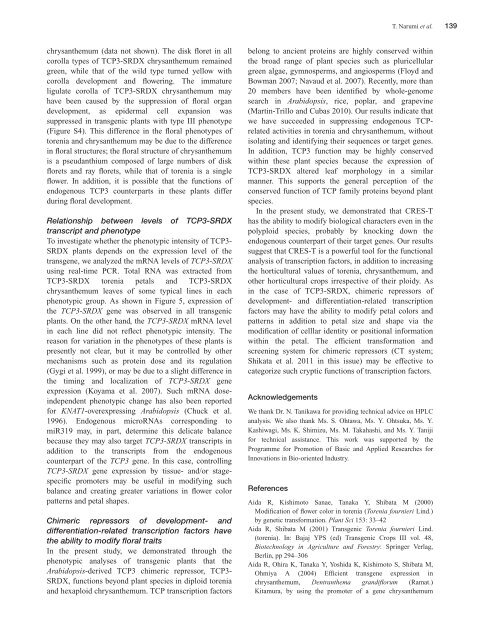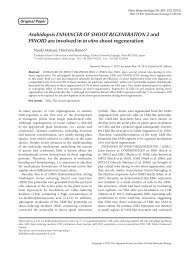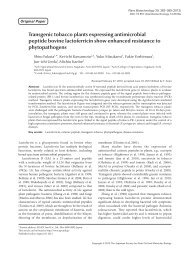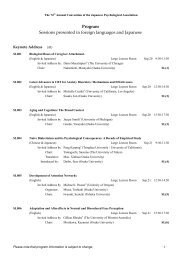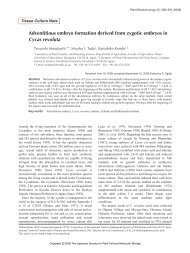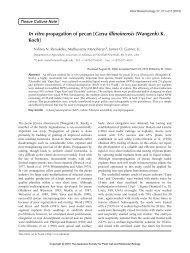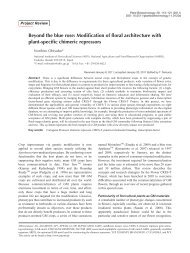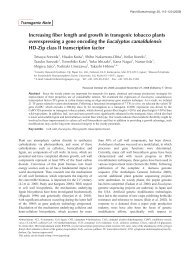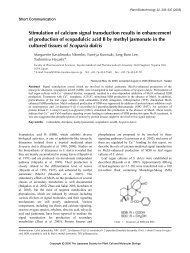Plant Biotechnol. 28(2): 131-140 (2011) - Wdc-jp.biz
Plant Biotechnol. 28(2): 131-140 (2011) - Wdc-jp.biz
Plant Biotechnol. 28(2): 131-140 (2011) - Wdc-jp.biz
Create successful ePaper yourself
Turn your PDF publications into a flip-book with our unique Google optimized e-Paper software.
T. Narumi et al. 139<br />
chrysanthemum (data not shown). The disk floret in all<br />
corolla types of TCP3-SRDX chrysanthemum remained<br />
green, while that of the wild type turned yellow with<br />
corolla development and flowering. The immature<br />
ligulate corolla of TCP3-SRDX chrysanthemum may<br />
have been caused by the suppression of floral organ<br />
development, as epidermal cell expansion was<br />
suppressed in transgenic plants with type III phenotype<br />
(Figure S4). This difference in the floral phenotypes of<br />
torenia and chrysanthemum may be due to the difference<br />
in floral structures; the floral structure of chrysanthemum<br />
is a pseudanthium composed of large numbers of disk<br />
florets and ray florets, while that of torenia is a single<br />
flower. In addition, it is possible that the functions of<br />
endogenous TCP3 counterparts in these plants differ<br />
during floral development.<br />
Relationship between levels of TCP3-SRDX<br />
transcript and phenotype<br />
To investigate whether the phenotypic intensity of TCP3-<br />
SRDX plants depends on the expression level of the<br />
transgene, we analyzed the mRNA levels of TCP3-SRDX<br />
using real-time PCR. Total RNA was extracted from<br />
TCP3-SRDX torenia petals and TCP3-SRDX<br />
chrysanthemum leaves of some typical lines in each<br />
phenotypic group. As shown in Figure 5, expression of<br />
the TCP3-SRDX gene was observed in all transgenic<br />
plants. On the other hand, the TCP3-SRDX mRNA level<br />
in each line did not reflect phenotypic intensity. The<br />
reason for variation in the phenotypes of these plants is<br />
presently not clear, but it may be controlled by other<br />
mechanisms such as protein dose and its regulation<br />
(Gygi et al. 1999), or may be due to a slight difference in<br />
the timing and localization of TCP3-SRDX gene<br />
expression (Koyama et al. 2007). Such mRNA doseindependent<br />
phenotypic change has also been reported<br />
for KNAT1-overexpressing Arabidopsis (Chuck et al.<br />
1996). Endogenous microRNAs corresponding to<br />
miR319 may, in part, determine this delicate balance<br />
because they may also target TCP3-SRDX transcripts in<br />
addition to the transcripts from the endogenous<br />
counterpart of the TCP3 gene. In this case, controlling<br />
TCP3-SRDX gene expression by tissue- and/or stagespecific<br />
promoters may be useful in modifying such<br />
balance and creating greater variations in flower color<br />
patterns and petal shapes.<br />
Chimeric repressors of development- and<br />
differentiation-related transcription factors have<br />
the ability to modify floral traits<br />
In the present study, we demonstrated through the<br />
phenotypic analyses of transgenic plants that the<br />
Arabidopsis-derived TCP3 chimeric repressor, TCP3-<br />
SRDX, functions beyond plant species in diploid torenia<br />
and hexaploid chrysanthemum. TCP transcription factors<br />
belong to ancient proteins are highly conserved within<br />
the broad range of plant species such as pluricellular<br />
green algae, gymnosperms, and angiosperms (Floyd and<br />
Bowman 2007; Navaud et al. 2007). Recently, more than<br />
20 members have been identified by whole-genome<br />
search in Arabidopsis, rice, poplar, and grapevine<br />
(Martin-Trillo and Cubas 2010). Our results indicate that<br />
we have succeeded in suppressing endogenous TCPrelated<br />
activities in torenia and chrysanthemum, without<br />
isolating and identifying their sequences or target genes.<br />
In addition, TCP3 function may be highly conserved<br />
within these plant species because the expression of<br />
TCP3-SRDX altered leaf morphology in a similar<br />
manner. This supports the general perception of the<br />
conserved function of TCP family proteins beyond plant<br />
species.<br />
In the present study, we demonstrated that CRES-T<br />
has the ability to modify biological characters even in the<br />
polyploid species, probably by knocking down the<br />
endogenous counterpart of their target genes. Our results<br />
suggest that CRES-T is a powerful tool for the functional<br />
analysis of transcription factors, in addition to increasing<br />
the horticultural values of torenia, chrysanthemum, and<br />
other horticultural crops irrespective of their ploidy. As<br />
in the case of TCP3-SRDX, chimeric repressors of<br />
development- and differentiation-related transcription<br />
factors may have the ability to modify petal colors and<br />
patterns in addition to petal size and shape via the<br />
modification of celllar identity or positional information<br />
within the petal. The efficient transformation and<br />
screening system for chimeric repressors (CT system;<br />
Shikata et al. <strong>2011</strong> in this issue) may be effective to<br />
categorize such cryptic functions of transcription factors.<br />
Acknowledgements<br />
We thank Dr. N. Tanikawa for providing technical advice on HPLC<br />
analysis. We also thank Ms. S. Ohtawa, Ms. Y. Ohtsuka, Ms. Y.<br />
Kashiwagi, Ms. K. Shimizu, Ms. M. Takahashi, and Ms. Y. Taniji<br />
for technical assistance. This work was supported by the<br />
Programme for Promotion of Basic and Applied Researches for<br />
Innovations in Bio-oriented Industry.<br />
References<br />
Aida R, Kishimoto Sanae, Tanaka Y, Shibata M (2000)<br />
Modification of flower color in torenia (Torenia fournieri Lind.)<br />
by genetic transformation. <strong>Plant</strong> Sci 153: 33–42<br />
Aida R, Shibata M (2001) Transgenic Torenia fournieri Lind.<br />
(torenia). In: Bajaj YPS (ed) Transgenic Crops III vol. 48,<br />
<strong>Biotechnol</strong>ogy in Agriculture and Forestry: Springer Verlag,<br />
Berlin, pp 294–306<br />
Aida R, Ohira K, Tanaka Y, Yoshida K, Kishimoto S, Shibata M,<br />
Ohmiya A (2004) Efficient transgene expression in<br />
chrysanthemum, Dentranthema grandiflorum (Ramat.)<br />
Kitamura, by using the promoter of a gene chrysanthemum


